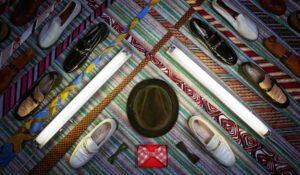Namati Film Project
Jerry Rothwell
We take the color white for granted—the brilliant white of Styrofoam cups, sunscreen, skimmed milk, and the lines on tennis courts. To produce it, manufacturers use titanium dioxide as a pigment, found in its most common natural form in a mineral called rutile.
Around a third of the world’s rutile is in Sierra Leone, which sits on 259 million metric tons of the stuff (currently valued at around $1000 per ton). To obtain this sought-after mineral, global mining companies negotiate licenses from government and tribal chiefs allowing them to excavate and sell it, often into the distant future.
But there’s an environmental and human cost to the brilliance of our whites, borne by the people who have lived for centuries on the ground above the rutile. They are rarely part of the deals struck to extract it. In the small village of Foinda, on the edge of a rutile plant in the south of Sierra Leone, villagers have lost farm lands—their water supply and the rivers that used to provide them with fish are polluted and lifeless. Over the last two decades they have been stripped of the opportunities for living with dignity, their survival dependent on the company’s water trucks.
Many communities the world over face a similar struggle to exercise even the most basic rights over their land and natural resources. Foinda’s case is typical of those supported by Namati, a movement of grassroots advocates who aim to put power in the hands of people in communities, by helping them understand, use, and shape the law.
In October, I travelled with Namati’s Sonkita Conteh to Utah to be part of the Sundance Stories of Change Lab where we spent a week translating their courageous and vital work into an idea for a film.

Sundance Institute’s Labs are legendary for filmmakers—an opportunity for intense creative focus in beautiful surroundings with generous and experienced mentors. This lab was the first to bring together filmmakers and those involved in social change to experiment with connecting storytelling projects to strategic action.
Native American spiritual leader Larry Cesspooch performed an inaugural blessing welcoming us to Ute traditional lands (on which Sundance operates), and from then on the relationship of people to land became an important theme. It was common to all four attending projects, which included work about the Amazon, Yawanawa culture, and Syria. They addressed crises brought about directly or indirectly by the relentless quest of capital for resources to feed on. And mining seemed to represent, not just resource exploitation, but the ambiguities and challenges of telling stories about these crises.
It’s intriguing how often we use the language of resource extraction in descriptions of the storytelling process. We speak of drilling down, of finding rich seams in a story, mining metaphors, unearthing character, as though stories exist before we tell them and just need digging out and cleaning up—“processing.” Perhaps it’s appropriate, because the metaphor of mining is double-edged.
When do stories become extractive, destructive even, for those who people them (“the raw material?”), transferring their riches elsewhere for the profit of others? Who benefits when filmmakers—the miners of stories—travel across distance and culture to bring back tales of the dispossessed?
Bringing together filmmakers, those whose stories are told and those who campaign for them, forces questions about who benefits from the story, why it is being made, who owns it, and what it could achieve. The Lab was a practical exploration of these questions, as well as of the creative work itself. Storytellers and social activists have much in common, but finding the points of difference is helpful for successful collaboration.
The storyteller wants to connect the subject matter to fundamental human experience, create something timeless and even mysterious that can touch the widest audience. The social activist needs to respond to the moment, and that can mean a need for targeted simplicity because immediate visible physical impact might be more important than a slow change in hearts or minds.

So the tension between purpose and art is at the heart of the relationship between the activist and the storyteller (even if those roles are embodied in the same person – the activist storyteller). As a filmmaker my gut reaction to being asked about a film’s message is to protect it from so narrow a description. It’s not that I don’t want the film to motivate change, but the relationship I want to establish with an audience is that “we will explore this thing together” rather than “I will tell you how it is”—actively seeking rather than passively receiving.
All stories have a function, but if we are overly conscious of it, does it break something in the telling? Must good stories have a life of their own, and spiral out in ways we wouldn’t expect, because they mimic the specificity of experience? Or is it self-indulgent to claim the primacy of an artistic process? As activists proclaimed in the ‘60s, at what point do you keep writing the poem when the house is burning down?
Perhaps we are aiming for a conscious distance, at least during the making, in which the storyteller does not craft a story to a function but shares the social motivations with the activist. As artist Lynette Wallworth said during discussions, we’re not documenting something, but igniting something.
Ellen Schneider of Active Voice has great experience in navigating activist-filmmaker collaborations and suggests that the collaboration is best described as looking together at the same point on the horizon – that fundamental agreement, the alignment of long-term goals, is more important than incidental agreement about the details of the journey.
Ellen suggested the importance of a “prenup”—ground rules between filmmaker and activist that put our differing expectations on the table from the start: who has editorial control, how long and deep does the collaboration go, what needs to be in the film and what can exist outside of it in resources or other versions.
It’s possible to envisage a world in which the $259 billion dollars worth of rutile in Sierra Leone benefits its people as well as global mining companies; that it results in fair and sustainable development, public infrastructure, and health and education systems. To achieve this will take a movement, intergovernmental action, changes in laws.
The contribution a truthful, complex story can make is to help us inhabit and understand, to leap over the brilliant white wall that divides us from the lives of others. The partnership between filmmaker and social activist becomes the vital work, beyond the story, of linking an imagined better world to a strategy to build it.







